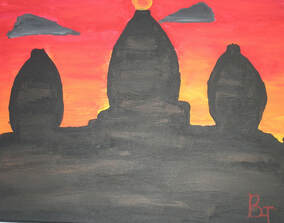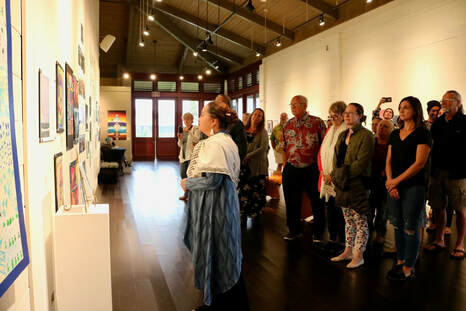This year’s theme is: “Ka Wai E Ola, E Ola Nō A”; Water is sacred, Water is our responsibility, Water is Life. The artwork of Waimea students, family and community members graced the walls with the story of a raindrop, that most important first element of life, each piece, like one of many raindrops, blending together to tell the story of life, ola wai.
We gather on the threshold of the makai lobby gallery and as the rain drums out a tattoo, cultural practitioner Kalani Flores journeys ahead, chanting into the far reaches and offers a pikai, a clearing, cleansing and blessing. We gather close as Pua Case, our guide, asks us to imagine ourselves as a single drop of rain to begin our travels from the highest mountain to the deepest sea through the eyes of Waimea artists.
“The exhibit will take us as a drop from the sky to the mountain to the hillsides, from rainfall to waterfalls to waterways of Waimea, down to the seaside, fish ponds and finally to the far reaches of the ocean,” reflected Pua.
This great connection with water is built into the Hawaiian language in the most fundamental question: O wai kou inoa? What is your name? Or more accurately: Who is your water? Who nourishes you? But we are all nourished by Kāne and for this exhibit the question is: Aia i hea Ka Wai a Kāne? (Where is the water of Kane?)
Out there with the floating Sun,
Where the cloud-forms rest on Ocean’s breast,
Uplifting their forms of Nihoa,
This side the base of Lehua.
We enter the spiritual realm of all those who have gone before seeking knowledge and understanding of their world. Together we ponder beginnings and the sacred monuments humans have built that connect us to the sacredness above.
On Hawai`i Island that connection is received through Mauna a Wākea and the exhibit begins with a photo by Kapulei Flores in celebration of the constant presence of Poliahu in her mountain realm. This is followed by “Power of Mana” by Amy Gordon and “Snow on Mauna Kea” by Shelly Stimac, both community artists.
 Anghor Wat by Brayden Jadulang.
Anghor Wat by Brayden Jadulang. Moving east, we travel to Cambodia and the mysterious Anghor Wat, a massive temple to the Hindu god Vishnu and later a Buddhist place of worship. Built to represent Mt. Meru, the home of the gods, some of its towers line up with the sunrise at solstice.
 Top: photo of Pua's journey to Stonehenge. Below: "Pua at Stonehendge" by Tina Yohon. Photo by Kapulei Flores, Kapzphotography.
Top: photo of Pua's journey to Stonehenge. Below: "Pua at Stonehendge" by Tina Yohon. Photo by Kapulei Flores, Kapzphotography. We travel further east and north, to Stonehenge, an ancient astronomical site in England, as well as a place of worship and healing, and the destination of a spiritual journey for Pua Case, who brought waters from Mauna a Wākea to Stonehenge as an offering and was gifted waters in return.
North of England in the Orkney Islands stand the Ring of Brodgar. There are many unanswered questions about this monument, but it stands as testament to early worshipers.
 Ahu Akivi by Goddess Gonsalves.
Ahu Akivi by Goddess Gonsalves. Sweeping south we are at Kukulcan in Chitchen Itza, Mexico, an early observatory containing sight lines for 20 different phenomena such as eclipses, equinox and solstice.
Also in Mexico in the area called Dzibilchaltun is the Temple of the Seven Dolls, where there is evidence of the recording of the vernal equinox, as well as Cenote Xlakah, a pool whose secrets have been a window into the past.
South to Peru where we find the Intihuatana Stone, an ancient Incan ceremonial site for winter solstice, whose name means, “Place to tie up the sun”. (painted in acrylic by Waimea Middle School 6th graders Jusani Dickens and Mikayla Pesta.)
And the last stop before returning home is Rapa Nui, where we find Ahu Akivi (by Goddess Gonsalves, Waimea Middle School 6th grade). These standing stones, or moai, are aligned to note the equinoxes and are believed to represent the ancestors, kings and important clan leaders of the original indigenous people.
Yonder on mountain peak,
On the ridges steep,
In the valleys deep,
Where the rivers sweep.
 "Womb of Mystery" by Kira DeGaetano Souza.
"Womb of Mystery" by Kira DeGaetano Souza. “The Gift of Life” by son, Joaquim Souza, shows us the heart of the mauna and how it holds the waters of life for us.
The Flores / Case `ohana created a photo essay that tells the story of their connection to Manaua, the sacred rain rock of our Waimea where the community from child to elder bestow gifts of leis to ask for rain and leis to offer in gratitude when the elements provide. Another image is of the `ohana gathered at a sacred place where sacred waters have emerged to form a pond among the rolling green landscape.
In the driving rain, in the heavenly bow,
In the piled-up mist wraith,
in the blood-red rainfall
In the ghost-pale cloud form;
 The many guises of water. Photo by Kapulei Flores, Kapzphotography.
The many guises of water. Photo by Kapulei Flores, Kapzphotography. In the heavenly blue, in the black piled cloud,
In the black cloud,
In the black mottled sacred cloud of the gods;
There is the water of Kāne.
This section contains the waterways of Waimea, an array of watercolors, acrylic, colored pencil and explores the patterns of water that surround and support us, showing an awareness of the seen and unseen water pathways, each piece a raindrop that forms a cloud of understanding.
In the ducts of Kāne and Loa,
A well of spring water, to quaff,
A water of magic power – The water of life!
Life! O give us this life!









 RSS Feed
RSS Feed
